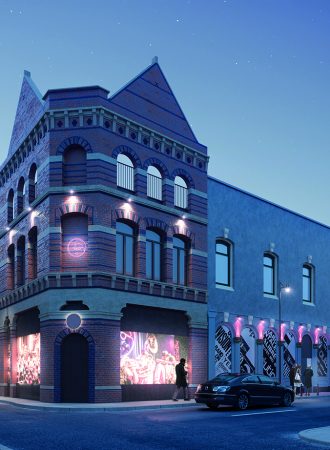Sitting on the terrace outside of Cane & Grain, drinking one too many frosty pints and enough red meat to make Fred Elliot wobble his chins with panic, little did I know that I was literally 2 metres away from some serious city history.
Also quite obvious is the fact that some of the old buildings on Thomas Street in the Northern Quarter have been knocked down, or at least – half knocked down – certainly raising some red flags as to the complexities (and ongoing controversies) of the area, but I’ll get on to that in a minute.

For the time being I’m going to look at the seemingly innocent-looking protruding door at number 46 Thomas Street, a rather dilapidated entrance set beneath a big red and white sign saying ‘SHOPFITTINGS (MANCHESTER)’.
The door is in fact the entrance to a World War Two air-raid shelter, of which there is an impressive amount of it left to display, as can be seen in these images captured by the Tunnel Inspector on Facebook.



During the conflict, the air-raid shelter was created in the cellars of 46 Thomas Street and 45 Back Turner Street, with a couple of entrances leading down to the safe haven, and the original stone roof of the basement being replaced by much sturdier concrete tiles and corrugated metal – favoured in people’s homemade Anderson Shelters across the country.
As you can see from the pictures, the air-raid shelter provides a window into the past, one that has seemingly been untouched or changed at all for more than 70 years.




And the same could be said for the whole building itself, and indeed the other half-knocked, half-fallen down structures just next to it – that have been surrounded by rather horrible boardings and scaffolding for a fair few years now.
This little stretch of Thomas Street has seen some controversial planning and development decisions over the years, and as a result is currently stuck in a limbo, one which includes developers, the council and Historic England all at loggerheads in the decision of what to actually do with them.

Credit: Joel Goodman
Historic England actually Grade-II listed this stretch of Thomas Street back in 2018, citing the buildings as being of particular ‘historic interest’; “as important contributors to Manchester’s pre-eminence as the world’s first industrial city”.
Apparently, this stretch of former industrial workshops from the 18th Century “provide unique contextual evidence as to the origins of industry in Manchester based on domestic-scale manufacturing.”

Credit: Joel Goodman
As a result, the buildings’ distinctiveness as urban workshop dwellings, erected through small-scale individual businesses in a rapidly expanding industrial city is also exacerbated by their rarity – and such have become protected from demolition and development, much to the frustration of developers and indeed many groups in the city.
Many would argue that the current dilapidated and dangerous state of the buildings, the majority of which need to be physically held up by scaffolding in order to not just crumble away, is down to a particular practice encouraged by landowners and developers – to simply sit on an historic building until it becomes too unsafe (and costly) to stay up, and then simply demolish and replace.

Plans were unveiled back in 2019 to turn this side of Thomas Street into a major new development under the name ‘Warp & Weft’, transforming one of the Northern Quarter’s most iconic streets with more space for bars, restaurants and retail, alongside apartments above.
These plans were greeted with both enthusiasm and distain from a variety of groups, some expressing concern that it would essentially destroy the last remaining vestiges of the uniqueness of the Northern Quarter, while others – well, anything is better than the current sorry state of the buildings.

And thus, the stalemate continues, with Historic England pushing back against any development plans and refusing to allow developers to simple demolish the structures, and developers wanting to start afresh and get building.
Personally, I think that the plans and the CGIs for the street seem a little ‘by-the-numbers’, and there’s a fear that developers would just turn this iconic stretch of the NQ into a soulless new build filled with boring restaurant chains and supermarkets. Let’s hope that they continue to champion the city’s independents and maintain the unique character of the NQ that we all love so much.

Something needs to be done though, and with the option of simply re-building and renovating the current buildings become less and less viable as the original structures crumble away by the day, the future of this important historical and cultural corner of the NQ never looked bleaker.
But July 2021 finally saw the council approve re-submitted plans for Warp & Weft, u-turning on their earlier decision of refusing to allow the demolition of the cottages, giving fresh hope that the project could finally be delivered.
The developer is now simply waiting for a decision from the Secretary of State, who will decide on whether or not to allow the plans to happen. If successful, work should begin immediately on this rather controversial slice of prime Northern Quarter real estate.
All the same though, and whatever happens to this little stretch of history, next time you’re walking past this pile of slowly rotting rubble and mortar, just remember – that protruding door under number 46 – it’s an air-raid shelter. Pretty cool.

